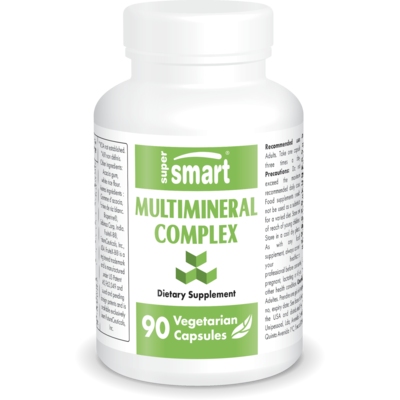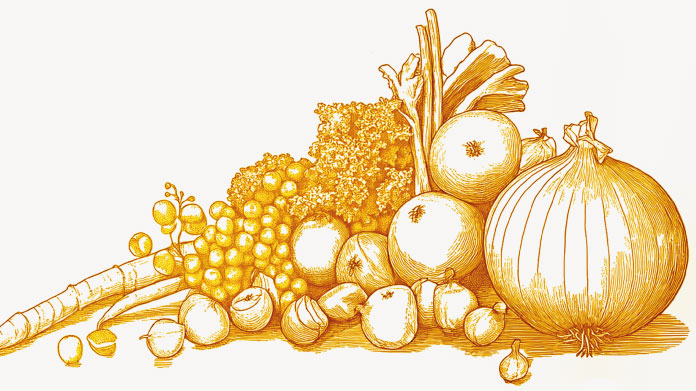Flu, Covid and bronchiolitis: how to tell them apart and how to treat them
This winter, we’re facing a particularly virulent triple epidemic of respiratory viruses. How can you tell these various illnesses apart, and how can you prevent and treat them?

Influenza: definition, symptoms and treatments
Influenza or flu is a contagious respiratory illness transmitted by an influenza virus. Usually mild, its symptoms include a high fever, dry cough, headache, aching muscles and intense fatigue (1-2).
In more vulnerable groups, however, such as new-born babies, those over 65 or immune-compromised individuals, it can cause serious complications (lung failure, exacerbation of chronic bronchitis, decompensation of asthma) (3).
The incubation period for flu is between 1 and 3 days. A person is contagious from the day before symptoms appear and may continue to be for up to a week. The virus is transmitted via airborne droplets (saliva and nasal secretions in coughs and sneezes) and also indirectly through touching contaminated surfaces (4).
Flu epidemics normally start in winter due to three conjunctive factors: we spend more time indoors in close proximity to others, our nasal mucous membranes become drier making it easier for the virus to invade, and the flu virus may survive better in the cold (5).
As most people recover by themselves, treatments are aimed at easing symptoms only - staying well-hydrated and taking painkillers and medication to reduce the fever and cough. Antivirals may be prescribed for more vulnerable individuals to prevent progression to more serious illness (6).
Covid-19: how it differs from the flu
First appearing in December 2019 in China’s Wuhan province, Covid-19 (which stands for COronaVIrus Disease 2019) is a viral respiratory infection transmitted by the SARS-CoV-2 coronavirus (7).
A feature of the Covid-19 virus is the wide variety of symptoms it produces (8). While some people remain asymptomatic, others display classic symptoms of a respiratory infection, such as fever or cough, combined perhaps with muscle pain, headache, sore throat or nasal congestion. In such cases, it’s particularly hard to distinguish it from the flu.
However, there are certain characteristics which are much more suggestive of a Covid infection, such as loss of taste (ageusia) or smell (anosmia) (9). Digestion-related problems (nausea, vomiting, diarrhea…) or skin issues (redness, rashes, chilblain-like symptoms…) have also been reported (10).
In more severe forms, which usually develop in the second week of infection, pulmonary tract symptoms may be associated with hyperinflammatory syndrome, causing shortness of breath (dyspnoea) and oxygen desaturation, which require the patient to be hospitalised (11).
Covid-19 also has a longer incubation period than flu (5-8 days) and a contagion period which starts 2-3 days before the first symptoms appear (12). Transmission gradually decreases until the 7th day of symptoms, but in exceptional cases, may continue until the 14th day.
It is transmitted in the same way as flu, namely by airborne droplets spread by coughing or sneezing, or by contact with contaminated surfaces. Hence the introduction of barrier measures (face masks, social distancing, washing hands with alcohol-based sanitizers…)
For mild to moderate forms, there is no recommended treatment, though paracetamol can be taken in order to bring down the temperature. However, non-steroidal anti-inflammatories or NSAIDs (such as Ibuprofen) are not recommended as they can reduce the body’s immune response. As of February 2022, doctors have been able to prescribe an anti-viral treatment (Paxlovid®) to those at higher risk of complications (13).
Bronchiolitis: the common infant infection
Bronchiolitis is a viral respiratory illness affecting the bronchioles (small bronchi). It is generally caused by an RSV (respiratory syncytial virus) (14).
Usually mild, it primarily affects babies and children under 2 during the winter period. It normally starts with a simple cold and mild cough. The coughing fits get worse over a few days before gradually improving. They may be accompanied by wheezing or difficulty breathing, and even fever. The child sometimes finds it hard to sleep or eat(15).
The virus can also affect older children and adults but without causing any symptoms, or at worst, a slight cold. However, it is still highly contagious and spreads silently among the population. It is easily transmitted by saliva, coughing and sneezing, and also remains on hands and objects (dummies, security blankets, toys…).
If you’re a parent of a baby or young child, there are specific steps you can take to prevent the spread of bronchiolitis (16):
- wash your hands for 30 seconds after touching your child;
- wash toys and stuffed animals regularly;
- ventilate your child’s room for 10 minutes a day;
- wear a mask, especially if you have a cold yourself;
- avoid confined or public places, especially if your baby is less than 3 months old;
- don’t share unwashed baby’s bottles, dummies or cutlery;
- don’t smoke in front of your child.
Fortunately, babies and childrennormally recover by themselves within 5-10 days though the cough may persist for 2-4 weeks. Treatment essentially consists of regularly clearing the nasal passages and feeding smaller amounts more frequently.
Hospitalisation is not usually necessary, except in the case of worsening symptoms in babies either aged less than 6 months, born prematurely or suffering from respiratory or heart disease.
A few tips for preventing illness and supporting your immune system
You can help avoid and stop the spread of winter viruses by adopting the following good habits:
- wash your hands regularly with soap and water or by rubbing them with an alcohol hand sanitiser (17);
- wear a mask in confined, poorly-ventilated places (such as public transport) especially if you have symptoms (18);
- air your living spaces every day (19);
- eat a diet rich in vitamins et minerals: fresh fruits and vegetables for their vitamin C content, oily fish for vitamin D… (20-21);
- make sure you get enough sleep, preferably 7-9 hours a night (22).
SuperSmart ADVICE
References
- Vabret A, Dina J, Cuvillon-Nimal D, Nguyen E, Gouarin S, Petitjean J, Brouard J, Freymuth F. La grippe saisonnière [Seasonal flu]. Pathol Biol (Paris). 2010 Apr;58(2):e51-7. French. doi: 10.1016/j.patbio.2010.01.009. Epub 2010 Mar 19. PMID: 20303676; PMCID: PMC7126553.
- Boktor SW, Hafner JW. Influenza. [Updated 2022 Jul 18]. In: StatPearls [Internet]. Treasure Island (FL): StatPearls Publishing; 2022 Jan-. Available from: https://www.ncbi.nlm.nih.gov/books/NBK459363/
- Ghebrehewet S, MacPherson P, Ho A. Influenza. BMJ. 2016 Dec 7;355:i6258. doi: 10.1136/bmj.i6258. PMID: 27927672; PMCID: PMC5141587.
- Moghadami M. A Narrative Review of Influenza: A Seasonal and Pandemic Disease. Iran J Med Sci. 2017 Jan;42(1):2-13. PMID: 28293045; PMCID: PMC5337761.
- Fong MW, Gao H, Wong JY, Xiao J, Shiu EYC, Ryu S, Cowling BJ. Nonpharmaceutical Measures for Pandemic Influenza in Nonhealthcare Settings-Social Distancing Measures. Emerg Infect Dis. 2020 May;26(5):976-984. doi: 10.3201/eid2605.190995. Epub 2020 May 17. PMID: 32027585; PMCID: PMC7181908.
- Robson C, Baskar SR, Booy R, Ferguson PE, Gilroy N, Kok J, Sandaradura I, Dwyer D. Influenza: overview on prevention and therapy. Aust Prescr. 2019 Apr;42(2):51-55. doi: 10.18773/austprescr.2019.013. Epub 2019 Apr 1. Erratum in: Aust Prescr. 2019 Jun;42(3):115. PMID: 31048938; PMCID: PMC6478960.
- Dhama K, Khan S, Tiwari R, Sircar S, Bhat S, Malik YS, Singh KP, Chaicumpa W, Bonilla-Aldana DK, Rodriguez-Morales AJ. Coronavirus Disease 2019-COVID-19. Clin Microbiol Rev. 2020 Jun 24;33(4):e00028-20. doi: 10.1128/CMR.00028-20. PMID: 32580969; PMCID: PMC7405836.
- Cascella M, Rajnik M, Aleem A, et al. Features, Evaluation, and Treatment of Coronavirus (COVID-19) [Updated 2022 Oct 13]. In: StatPearls [Internet]. Treasure Island (FL): StatPearls Publishing; 2022 Jan-. Available from: https://www.ncbi.nlm.nih.gov/books/NBK554776/
- Mullol J, Alobid I, Mariño-Sánchez F, Izquierdo-Domínguez A, Marin C, Klimek L, Wang DY, Liu Z. The Loss of Smell and Taste in the COVID-19 Outbreak: a Tale of Many Countries. Curr Allergy Asthma Rep. 2020 Aug 3;20(10):61. doi: 10.1007/s11882-020-00961-1. PMID: 32748211; PMCID: PMC7397453.
- Singh H, Kaur H, Singh K, Sen CK. Cutaneous Manifestations of COVID-19: A Systematic Review. Adv Wound Care (New Rochelle). 2021 Feb;10(2):51-80. doi: 10.1089/wound.2020.1309. Epub 2020 Oct 19. PMID: 33035150; PMCID: PMC8020517.
- Hu J, Wang Y. The Clinical Characteristics and Risk Factors of Severe COVID-19. 2021;67(3):255-266. doi: 10.1159/000513400. Epub 2021 Jan 6. PMID: 33406518; PMCID: PMC7900480.
- Quesada JA, López-Pineda A, Gil-Guillén VF, Arriero-Marín JM, Gutiérrez F, Carratala-Munuera C. Incubation period of COVID-19: A systematic review and meta-analysis. Rev Clin Esp (Barc). 2021 Feb;221(2):109-117. doi: 10.1016/j.rceng.2020.08.002. Epub 2020 Nov 28. PMID: 33998486; PMCID: PMC7698828.
- Najjar-Debbiny R, Gronich N, Weber G, Khoury J, Amar M, Stein N, Goldstein LH, Saliba W. Effectiveness of Paxlovid in Reducing Severe COVID-19 and Mortality in High Risk Patients. Clin Infect Dis. 2022 Jun 2:ciac443. doi: 10.1093/cid/ciac443. Epub ahead of print. PMID: 35653428; PMCID: PMC9214014.
- Justice NA, Le JK. Bronchiolitis. [Updated 2022 Jun 27]. In: StatPearls [Internet]. Treasure Island (FL): StatPearls Publishing; 2022 Jan-. Available from: https://www.ncbi.nlm.nih.gov/books/NBK441959/
- Erickson EN, Bhakta RT, Mendez MD. Pediatric Bronchiolitis. [Updated 2022 Jun 27]. In: StatPearls [Internet]. Treasure Island (FL): StatPearls Publishing; 2022 Jan-. Available from: https://www.ncbi.nlm.nih.gov/books/NBK519506/
- Drysdale SB, Green CA, Sande CJ. Best practice in the prevention and management of paediatric respiratory syncytial virus infection. Ther Adv Infect Dis. 2016 Apr;3(2):63-71. doi: 10.1177/2049936116630243. Epub 2016 Feb 10. PMID: 27034777; PMCID: PMC4784570.
- Toney-Butler TJ, Gasner A, Carver N. Hand Hygiene. [Updated 2022 Aug 1]. In: StatPearls [Internet]. Treasure Island (FL): StatPearls Publishing; 2022 Jan-. Available from: https://www.ncbi.nlm.nih.gov/books/NBK470254/
- Liang M, Gao L, Cheng C, Zhou Q, Uy JP, Heiner K, Sun C. Efficacy of face mask in preventing respiratory virus transmission: A systematic review and meta-analysis. Travel Med Infect Dis. 2020 Jul-Aug;36:101751. doi: 10.1016/j.tmaid.2020.101751. Epub 2020 May 28. PMID: 32473312; PMCID: PMC7253999.
- Ferrari S, Blázquez T, Cardelli R, Puglisi G, Suárez R, Mazzarella L. Ventilation strategies to reduce airborne transmission of viruses in classrooms: A systematic review of scientific literature. Build Environ. 2022 Aug 15;222:109366. doi: 10.1016/j.buildenv.2022.109366. Epub 2022 Jul 7. PMID: 35818484; PMCID: PMC9259197.
- Shakoor H, Feehan J, Al Dhaheri AS, Ali HI, Platat C, Ismail LC, Apostolopoulos V, Stojanovska L. Immune-boosting role of vitamins D, C, E, zinc, selenium and omega-3 fatty acids: Could they help against COVID-19? Maturitas. 2021 Jan;143:1-9. doi: 10.1016/j.maturitas.2020.08.003. Epub 2020 Aug 9. PMID: 33308613; PMCID: PMC7415215.
- Shaik-Dasthagirisaheb YB, Varvara G, Murmura G, Saggini A, Caraffa A, Antinolfi P, Tete' S, Tripodi D, Conti F, Cianchetti E, Toniato E, Rosati M, Speranza L, Pantalone A, Saggini R, Tei M, Speziali A, Conti P, Theoharides TC, Pandolfi F. Role of vitamins D, E and C in immunity and inflammation. J Biol Regul Homeost Agents. 2013 Apr-Jun;27(2):291-5. PMID: 23830380.
- Besedovsky L, Lange T, Born J. Sleep and immune function. Pflugers Arch. 2012 Jan;463(1):121-37. doi: 10.1007/s00424-011-1044-0. Epub 2011 Nov 10. PMID: 22071480; PMCID: PMC3256323.
Keywords
1 Days
The ordering process is very user…
The ordering process is very user friendly and the products always come in a timely manner.
CARTER Rhonda
2 Days
The price for Dr
The price for Dr. Pero's AC-11 is reasonable and in line with his views. (my former colleague). Keep it pure.
CAMPBELL Clayton
4 Days
Right on every time.
Right on every time.
Arthur Nicholas
7 Days
They are cheaper than everyone else and…
They are cheaper than everyone else and the shipping was fast. Great company.
Patricia Adams
14 Days
Availability of quality health…
Availability of quality health supplements and it's wide variety is impressive. Ordering is seamless and shipping even during the holidays is well streamlined.
Mohamad Hussein
28 Days
A Product worth waiting for when not…
A Product worth waiting for when not available and then arriving as a surprise!
DOMINIC
30 Days
On time shipping
On time shipping
GEORGE Verne
32 Days
Ordering was easy and the product was…
Ordering was easy and the product was delivered with no problems. Appreciated that I was notified when it would arrive. Thanks!
MascarC
37 Days
Great customer service - responsive …
I ordered from them and my item was unavailable for sometime. I was super happy when they reactivated my order and shipped my item which arrived very quickly. Great customer service.
Ruth Rueter
38 Days
Super fast shipping
Super fast shipping
Donald Borling
41 Days
Reputable companysearch and the number of…
The research and the number of selection of products.
NAKHJAVAN Shervin
54 Days
The Anti Aromatase is a great product
The Anti Aromatase is a great product. You just need to have constant inventory. Recently this product has been out of stock.
GEORGE Verne
56 Days
Great help on chat
Great help on chat. Knowledgeable and friendly.
Jason Argos
59 Days
Customer service was fast and friendly.
Customer service helped to stop the transaction process of the subscription. I appreciated that.
Greenie
60 Days
I order here due to the high quality of…
I order here due to the high quality of the products and the quick delivery of items - thank you
Barbara J







